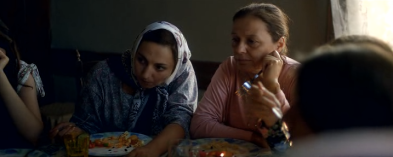Mustang
Dir. Deniz Gamze Ergüven
2015
Mustang came out in 2015 and reached audiences worldwide. It won several awards (2015 Cannes Film Festival: Europa Cinemas Label Award; 2015 Lux Prize; Best Feature Movie at Polish Filmmakers’ Association Award) and nominated for so many more. The film follows five orphaned sisters living in one of Turkey’s Black Sea (and conservative) villages. The sisters live with their father’s mother, a woman with good intentions who abides to small town pressures, and their uncle, who takes pride in being the man of the house – in all the worst ways.
The story is mostly shown from the perspective of the youngest, Lale. Through her eyes we watch her uncle enter the sisters’ shared rooms in the middle of the night as her grandmother tries to marry off each sister starting with the eldest. We watch all the sisters, especially Lale, deal with each challenge thrown at them. As we get to know each sister, Lale transforms from the youngest sister to the bravest and most determined character in the film. She goes from stuffing her shirt with apples (pretending she grew breasts overnight) to stealing the keys to her uncle’s Land Rover to try to teach herself how to drive.
In preparation for marriage, the sisters go through what Lale dubs a “wife factory.” Nameless teyzes (aunties) teach the girls how to perform an array of household chores from stuffing a comforter, sewing and cooking, and the girls reluctantly sit around the table mimicking their governesses. We watch a portly woman teach the sisters how to lay out vine leaves for stuffing – yaprak sarma. The woman tells the girls it is important not to fill a leaf with too much stuffing because it will turn  out too stiff – something that guests don’t like. In another scene, we watch the girls roll out dough into a thin layer, cut it in squares and drop dollops of ground meat into it – mantı. In the same scene, we see Lale examining a green pepper that will later be used for dolma.
out too stiff – something that guests don’t like. In another scene, we watch the girls roll out dough into a thin layer, cut it in squares and drop dollops of ground meat into it – mantı. In the same scene, we see Lale examining a green pepper that will later be used for dolma.
For all the beautiful shots and camera pans of food, rarely do we actually see the girls consuming the stuff. While they are around it, they aren’t eating it. So, the few instances when we do see them chewing are fairly important. In one scene, the TV blares a prime time soap opera in the background while the women in household, including the sisters, grandmother, and several unnamed women, sit around the table eating. The sisters, bored, push around the food on their plates and occasionally bring forks to  their mouths. Meanwhile, with their eyes glued to the screen, the other women mindlessly put food in their mouth. Without looking at what they are eating, it’s clear that the contents of their plates are of no consequence – they could be eating soil with tomato paste and probably wouldn’t realize. We see a similar behaviour when Ece, the middle sister, finds out she is to be married off. In a meeting arranged by her grandmother, Ece is introduced to her potential suitor. As with her two older sisters, Ece serves the family tea, coffee, and a variety of cookies from a blue tin box that the suitor’s family brought. After serving everyone, she takes a seat next to her grandmother, and puts one biscuit into her mouth, followed by another.
their mouths. Meanwhile, with their eyes glued to the screen, the other women mindlessly put food in their mouth. Without looking at what they are eating, it’s clear that the contents of their plates are of no consequence – they could be eating soil with tomato paste and probably wouldn’t realize. We see a similar behaviour when Ece, the middle sister, finds out she is to be married off. In a meeting arranged by her grandmother, Ece is introduced to her potential suitor. As with her two older sisters, Ece serves the family tea, coffee, and a variety of cookies from a blue tin box that the suitor’s family brought. After serving everyone, she takes a seat next to her grandmother, and puts one biscuit into her mouth, followed by another.

Throughout the film, food and its preparation become reminders of the girls’ (intended) duties: domestic service. More specifically, service to their future husbands and his family. But the consumption of these edibles acts as a symbol of conformity, or perhaps a sign of surrender.
That said, there seems to be another layer to cooking that lies beneath its domestic symbolism. In another scene, the same women who taught the girls how to prepare mantı finds Lale lying on the ground in the house, after she was asked to leave a soup-teaching session. The next shot, the two of them are in the kitchen and the portly woman is showing, to Lale’s surprise, how to make chewing gum with milk and mastic. Lale returns to her sisters with the gum. Their excitement leads to a spree of dress tearing and skirt ripping.
With the homemade chewing gum – something in which the girls are not allowed to indulge – food and its consumption also acts as a subversive tool. The beautiful shots of all the food make the viewer aware of traditional domesticity that is tied to these dishes. And, yet the chewing gum shows us how we can turn a stubborn tradition on its head.
